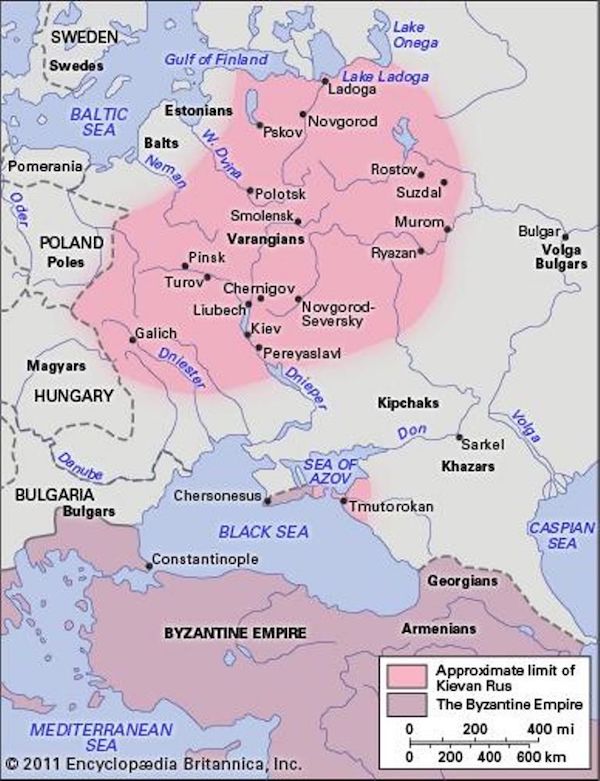Greeks and Arabs, Furs and Death
Episode #7 of the course Vikings: History and mindset by Tom Shippey
Welcome to Lesson 7!
About the same time as the Norwegians began probing into the North Atlantic, Swedes began to probe down the great rivers of Eastern Europe: the Dnieper and Don, which led to the Black Sea and the Byzantine Empire, the Volga to the Caspian Sea and the Caliphate of Baghdad.
These newcomers were called “the Rus.” They called their new territory, Gartha-riki, after the garths, or forts, they set up at Holm-garth (Novgorod, present Russia) and Konu-garth (Kyiv, Ukraine). Today, we’ll talk about how Vikings lived and made business there.

Kievan Rus in the 11th century.
Trading and Raiding with the Greeks
They soon came under the scrutiny of civilized observers. Emperor Constantine wrote a book, On the Governance of Empire, which has a section on the Rus.
What impressed him was their cohesion. Their habit was to assemble their boats at Kyiv in the spring and come downriver to trade, all together, ready to fight. If one boat got stranded, the rest all pulled in. Dangerous places were the barrages on the Dnieper, where goods and boats had to be portaged and where the steppe nomads were likely to try an ambush.
Peaceful traders, then? But what were they trading?
Furs, mainly, but the Rus did not do the trapping themselves. They extorted the furs as tribute, or “protection money,” from their Slavic subjects. These luxury goods commanded high prices. A rare black fox skin might go for 100 gold dinars in Baghdad.
A beautiful girl was worth more, as much as 150 gold dinars. By contrast, when Icelander Hoskuld bought an Irish girl in Sweden from Gilli the Russian, she cost him only a pound and a half of silver, and that was three times the normal price. The markup between Sweden and Baghdad was fantastic. Of course, girls cost the slavers who captured them nothing.
So, trade was peaceful at the selling end. But the goods were obtained by violent marauding.
Byzantium was also an irresistible target. The Rus raided it again and again, with mixed results. In 860, they caught the Greeks by surprise; in 907, they were expensively bought off; in 941, they ran into the Byzantine secret weapon, “Greek fire,” and were destroyed. In 971, they were bought off again—though the nomads caught Prince Svyatoslav of Kyiv on the return trip and made a cup out of his skull.
Opinion in the Muslim World
Muslim observers were also very impressed. “A formidable nation,” wrote one, “the men huge and very courageous. They do not recognize defeat.” Another wrote, “They never quit the battlefield without having slaughtered their enemy. They are remarkable for their size, their physique, and their bravery.”
Not surprisingly, when the Rus made a great raid into the Caspian in 912, they dealt with the local defense forces easily. But they were unable to suppress what we could call “insurgency.” They also suffered badly from disease, probably dysentery. On the way back, loaded with loot, they were ambushed, like Svyatoslav, by the Khazars, who had let them pass when they were empty-handed.
Distance in Russia has always been the problem for invaders. The “Yngvar runestones” of Sweden commemorate many men who did not come back from a later raid south.
A Sad Encounter
One account has become famous. About 921, a traveler from Baghdad ran into a group of “the Russiyah” on the Volga and observed the funeral of a Rus leader.
This involved the sacrifice of a slave-girl. After long preparations had been made, she was gang-raped by the other Rus, strangled, and stabbed by an old woman called “the Angel of Death,” and then burned with the dead man in his boat.
As usual, liberal historians don’t want to believe this. Even if it’s true, they argue, the Rus must have been Slavicized (like their prince, Svyatoslav). On the other hand, several details have been confirmed archaeologically from Scandinavia.
One has to face facts. When they were on top, Vikings were robbers, slavers, and murderers.
The admirable thing about them was their courage when they were down. This is the subject of the next lesson.
Recommended books
The Viking Road to Byzantium by Hilda Ellis Davidson
Ibn Fadlan and the Land of Darkness, trans. by Paul Lunde and Caroline Stone
Share with friends
